- Home
- Ricoh Global Newsroom
- Stories
- Why Small Units within Big Companies Must Step Up to the Plate to Resolve Social Issues
Special Dialogue
2022.05.10
Why Small Units within Big Companies Must Step Up to the Plate to Resolve Social Issues
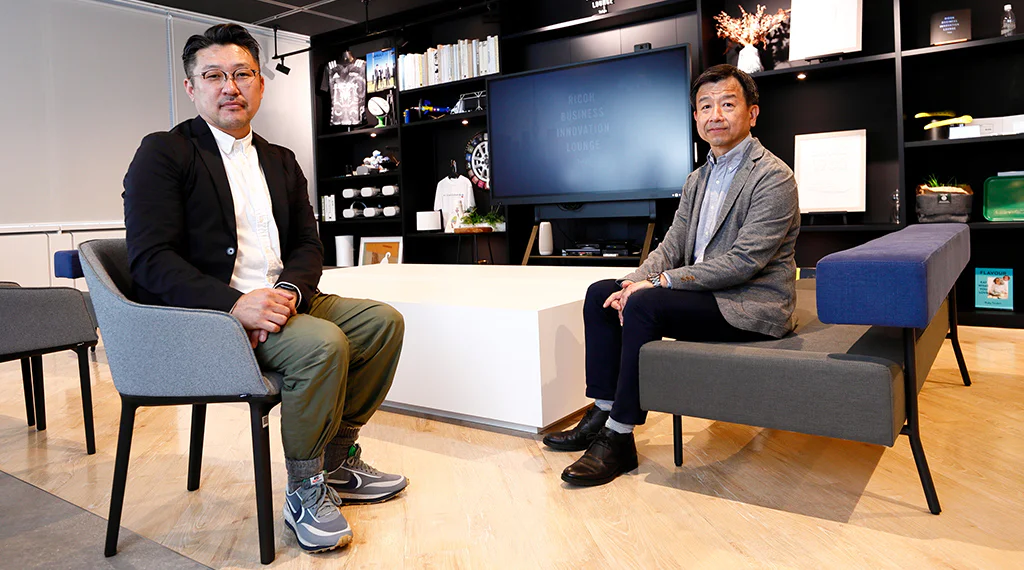
Written by BUSINESS INSIDER JAPAN
Index
What’s important amid the rapid evolution of technology is how best to use it.
“You need a philosophical basis for leveraging technology,” says Seiichi Saito, president of Abstract Engine Co., Ltd., a media arts, advertising, and entertainment firm. He also heads its Panoramatiks unit, which engages in consulting, vision and social design, and urban, regional community, and facilities development, and also pursues regional revitalization and smart city progress. He has participated in numerous government projects in recent years, affording him a birds-eye view of long-term technological and industrial prospects.
This conversation explores the relative merits of big companies and small organizations and where governments can lead initiatives.
Creative guru Mr. Saito and Takahiro Irisa, president of the Ricoh Futures business unit, sat down to discuss how best to resolve social issues. That Ricoh business unit’s mission is to contribute to such solutions by leveraging proprietary technologies.
Philosophy is all about finding your purpose
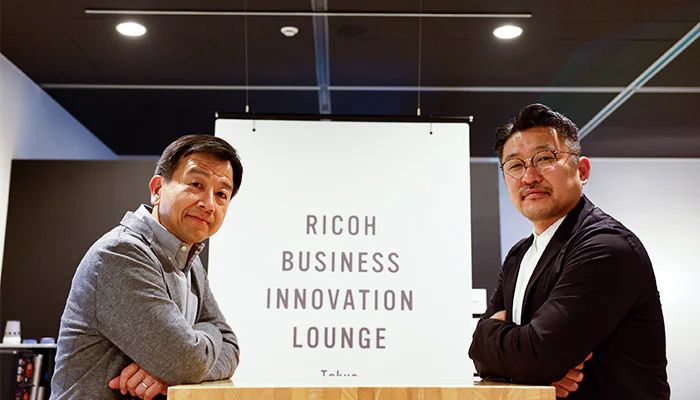
Ricoh’s state-of-the-art value co-creation facility hosted a discussion between Panoramatiks head Seiichi Saito (right) and Ricoh Futures head Takahiro Irisa
Mr. Saito, you’ve said on various occasions places that philosophy is important in this day and age. Could you both elaborate on your thoughts about philosophy?
Saito: I find it interesting that while organizations and companies would like to join forces to create new industries they are moving all over the map. It would serve us all well to define common purposes so we can create things together instead of competing.
We’re saturated with devices and formats these days. I think we need to rethink where we’re going.
Irisa: I joined Ricoh 30 years ago. My tasks were clear to me for much of that time. I simply had to do what was necessary. But our planet has run into trouble in recent years, forcing me to reconsider the rationale for my job. I believe that business has meaning and value when you help resolve the world’s problems. So, rather than refine what we have, we should work out where the world should head and how we as people should act. We should find our purpose. That’s my philosophy these days.
Saito: I had an opportunity to work with Ricoh a long time back. The company was offering a service to store documents on the cloud. Given that the business of MFPs printing documents on paper was worth trillions of yen, you could say the company was cannibalizing itself in the short term. But the service was necessary over the long run in view of where society was heading.
I was impressed that Ricoh had what Jack Welch would call a small company soul in a big company body, with virtually instantaneous decision-making processes.
Looking to demonstrate new technology approaches at Expo 2025 and push ahead with reforms behind the scenes
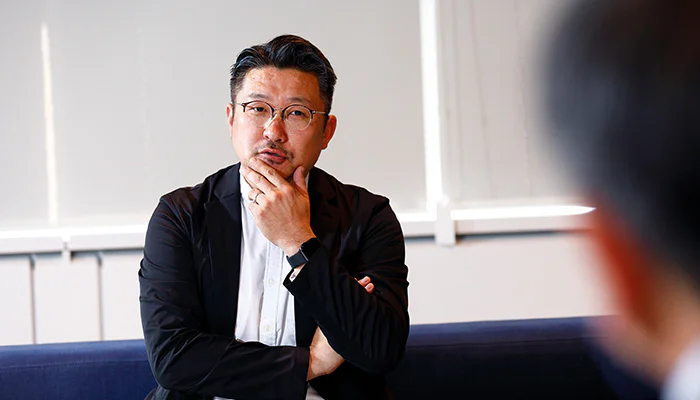
Seiichi Saito
Seiichi Saito was born in 1975. He obtained a Bachelor of Architecture from the Tokyo University of Science. He later received a Master of Science degree in Advanced Architectural Design from the Graduate School of Architecture of Columbia University. He began working in New York in 2000 as a creative for the Arnell Group, which is part of the Omnicom Group. He established Rhizomatiks Inc. (now Abstract Co., Ltd.) after working as a freelance creator. He was a creative advisor for the Japan Pavilion at the Expo 2020 in Dubai, and is an expert for the People’s Living Lab Promotion Council for Expo 2025 in Osaka.
Irisa: We create technology. That’s what we do. For example, we have a compact sensor that can measure temperature, humidity, air pressure, illuminance, and residual rechargeable battery power, transmitting data by Bluetooth. It is powered by indoor lighting, and there is no need to replace the batteries.
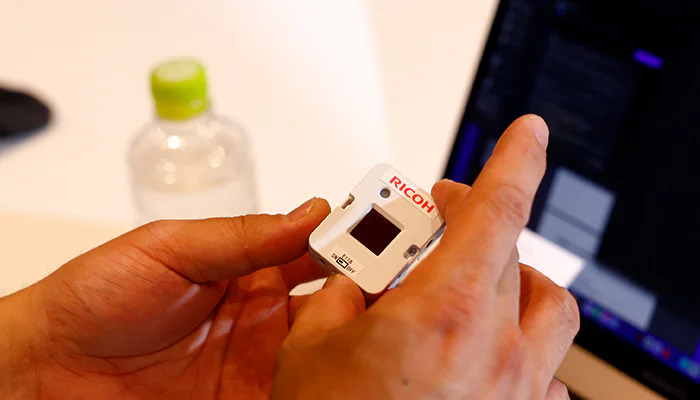
Solar power is popular now, but making solar panels emits carbon dioxide. Then there are issues with maintenance after 10 or 20 years even if you install the panels in underpopulated areas. Using an advanced version of perovskite in this sensor technology enables you to create film based power cells. You could thus develop local power production sources for local consumption, such as in home walls, automobiles, and on roads.
It would be really cool, for example, if a city were to generate its own electricity with renewables and showcase the achievement. It would be truly exciting if the government were to take the initiative and fund the creation of such a city and if companies and creators were play shared roles in all this. I’m sure that engineers would be keen participants.
Saito: I remember that at the CES 2006 consumer electronics trade show in Las Vegas manufacturers from everywhere showcased their own LCD panels. That didn’t seem particularly smart to me. Digital technology has become so much part of the infrastructure that it’s hard to get a competitive edge. Instead of everyone developing similar things, it would be better for the right people at companies to hoist the flag as it were and drive work on technologies that matter.
That’s what I want to help make happen at Expo 2025. That’s why I set up the Expo Outcome Design Committee in December 2021, through which I look to hoist the flag for what’s useful in communications, energy, materials, and other fields.
Irisa: One thing we’re developing is a product called PLAiR. It’s a new material that should replace conventional plastics. PLAiR foamed sheets are made with plant-derived polylactic acid.
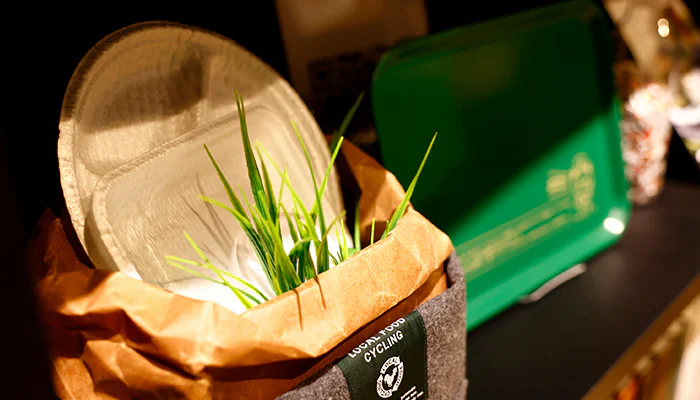
As the raw material, plants absorb carbon dioxide as they grow. Even if you incinerate PLAiR, net atmospheric carbon dioxide levels do not increase. After product use, the material degrades into water and carbon dioxide in soil or in compost. It’s definitely important to recycle regular plastics, but the carbon dioxide issue won’t go away as long as plastics are fossil-derived. You can endlessly reduce these emissions with PLAiR. So, there are technologies other than recycling that can prevent carbon dioxide emissions without people having to change their lifestyles.
Saito: We want to highlight something like that at Expo 2025! You can create a new category that isn’t recycling. If you were to present polylactic acid-based material and virgin plastic consumers might choose the latter but if the public and private sectors both adopt a policy of using the former then users will be able to help safeguard the Earth without being particularly conscious of their contribution. I think people engaged in design should take the initiative to incorporate such approaches in their processes.
Open innovation is a must for resolving social issues
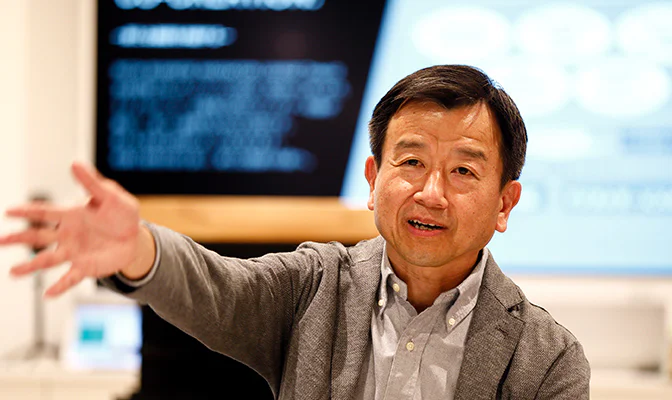
Takahiro Irisa
Takahiro Irisa is president of the Ricoh Futures business unit. He was born in 1965 in Kagoshima Prefecture. He joined Ricoh in 1989, working in the IMS Business Group. He was posted to France in 2007, overseeing a unit that took up the challenges of launching new businesses. He entered the Corporate Planning Division in 2017 and took up his current post in 2021. He lives in Chigasaki, Kanagawa Prefecture, where he enjoys windsurfing, continuing a passion for the sea that started with his membership of his university’s sailing club.
Saito: There are some areas in which governments have to invest because they may be beyond the practical reach of the private sector. Maps are the best example of that. By law, each region must conduct a geographical survey every five years. Instead of the private sector starting from scratch with maps, it’s more efficient for them to tap data from local governments and put an overall infrastructure in place. We need to delineate state-led co-creation and earnest corporate competition.
Irisa: Surveying is relevant to our business. You normally need very expensive large vehicles to measure road surface conditions. But we developed technology for stereo cameras for inspection systems that you can deploy on regular vehicles, making it easy to undertake measurements and increase their frequency.
Summer 2021 saw a tragic landslide in the resort town of Atami after torrential rains. I had driven along a bridge in Atami dozens of times on the way to Shirahama in Izu Peninsula to pursue my passion of marine sports. I was shocked to see the destruction in the news. I discussed the situation with a Ricoh technical team, and we launched a project to resolve such issues. To prevent similar disasters, we are working with Miyazaki Prefecture to measure the condition of all hillsides. Our digital technology will make it possible to assess slopes more efficiently than ever before. If we can thereby contribute to safer urban development, we will endeavor to make the hardware technology open and co-create with other players.
Saito: Some companies want to keep everything as closed as possible and retain intellectual property rights. They are afraid of what might happen if they let things out into the open. But if we can’t co-create if we don’t reach out to others.
Irisa: The more I thought about it, the more I realized that co-creation is vital to resolve social issues. Open innovation is the key to such efforts. That said, However, I think that co-creation without holding intellectual property differs from the perspectives you get when keeping your business sustainable as a private company. Our policy is to maintain such property while remaining open to the necessary elements of co-creation. Our greatest advantage is speed. So, as long as we can operate in line with our policy we can become useful to society and contribute to a better world.
Saito: I believe that co-creation comes not just from business-to-business efforts but also from collaboration between individuals.
I once visited each house in a certain section of a city to interview the people there because I didn’t want to simply consider them faceless residents. I began to learn about each of these individuals. There was a husband working for a video game firm, a wife employed by a cell phone company, and there were housewives, and so on and so forth. The experience underscored that everyone is ultimately both a consumer and a producer.
When unconventional values like ESG emerge, what used to sell well may no longer attract much demand. I think the world should be a place in which we can all voice our views and act independently. If we all act like producers we can independently prefer a recycled product with a muddy hue over an item that is pure white virgin plastic. I think we can choose good things in this way.
Fostering diversity and developing organizational skills
Resolving social issues through technology requires creativity. How can we create organizations that leverage creative skills?
Irisa:It’s quite a challenge, but let me preface that by touching on diversity. I worked in France for four years from 2007. Lots of women hold management positions there or have professional skills. In contrast, Japanese society is still male-dominated. We need to create a better gender mix.
The other point to note is to take advantage of the qualities of individuals. Surveys of such qualities generally reveal the same trends. Science grasps human characteristics fairly well. The trouble with large companies is that they assign people to jobs without factoring in their talent. People sometimes have to do things they are poor at. But it’s better to develop the things they handle well. I want to build teams in which everyone can handle things they are proficient with so performances can improve. You need diversity for that.
Saito:We’re witnessing a sea change in values. Eyes have shifted away from good products at low prices toward what is environmentally beneficial and sustainable. GDP no longer tracks things that people consider important. I believe that we henceforth need to consider at the macro and micro aspects of design while keeping tabs on overall developments to bring everything together.
In my view, this is beyond the realm of training and is about thought processes. You don’t even have to be young to grasp them. I think it takes creative people like you to make decisions, involve a range of people, and encourage them to head in the right direction.
Irisa:I sense that the time has come for big companies to step up to the plate. They have people, goods, and funds. And at Ricoh we have a gung-ho attitude. Our people are always willing to give anything a try and get straight to work on it. If someone wants to do something and management believes that it will benefit society, it will usually greenlight the effort.
Saito:Likewise, I believe that we have entered an era in which small units in large companies can do important things.
What areas will you focus on in the years ahead, and what is your vision?
Saito:Rather than see purely free competition, I would like co-creation between the public and private sectors where flags are hoisted. I will leverage my philosophy in bringing organizations and people together.
Irisa:I found it really insightful that you spoke today about hoisting flags. If we do that we can lead the way. If we can’t, we can find and engage with flag raisers. I made a mental note to create mechanisms and initiatives that attract others people.
Resolving social issues will remain a firm focus. We don’t have to fret beforehand about whether or not we will succeed. What’s truly important is to believe and act on our convictions.